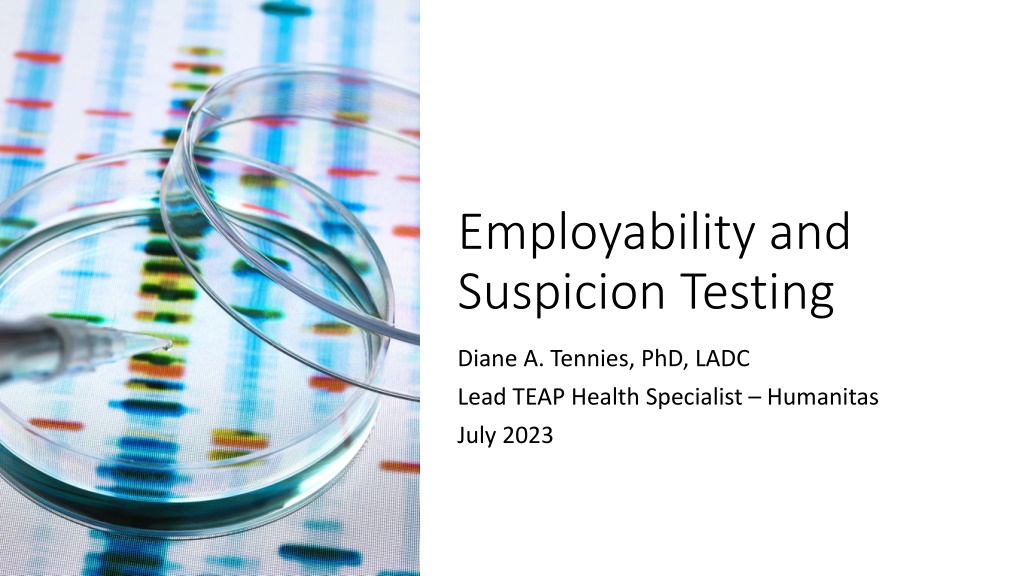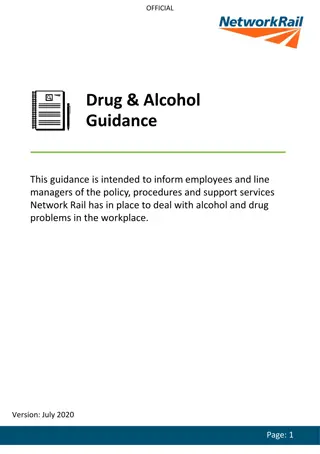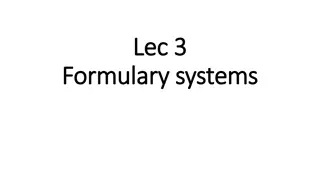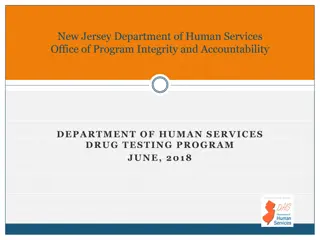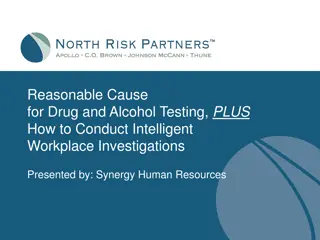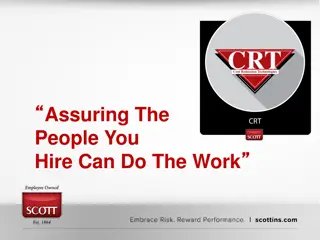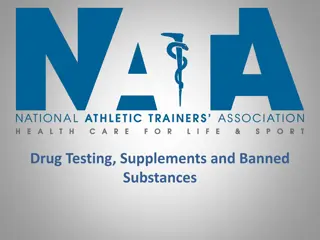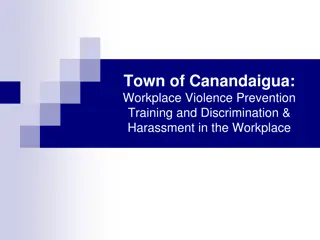Effective Workplace Drug Testing: Ensuring Safety and Productivity
Workplace drug testing is crucial for ensuring safety, productivity, and employee well-being. This practice helps prevent accidents, reduce absenteeism, and improve overall workplace morale. Through thorough screening processes and employee education, organizations can create a safe and healthy work environment while complying with regulations. Drug testing aids in identifying and addressing substance abuse issues, ultimately contributing to a more efficient and secure workplace.
Download Presentation

Please find below an Image/Link to download the presentation.
The content on the website is provided AS IS for your information and personal use only. It may not be sold, licensed, or shared on other websites without obtaining consent from the author. Download presentation by click this link. If you encounter any issues during the download, it is possible that the publisher has removed the file from their server.
E N D
Presentation Transcript
Employability and Suspicion Testing Diane A. Tennies, PhD, LADC Lead TEAP Health Specialist Humanitas July 2023
Learning Objectives 1.) REVIEW THE IMPORTANCE OF BEING DRUG-FREE IN THE WORKPLACE AND THE IMPACT ON EMPLOYABILITY. 2.) IDENTIFY THE THREE STEPS ASSOCIATED WITH THE SUSPICION SCREEN PROCESS THAT ARE BEHAVIOR-BASED. 3.) OUTLINE THE NECESSARY/REQUIRED PARTICIPANTS INVOLVED IN THE SUSPICION SCREEN PROCESS.
Drug testing is about workplace safety and worker health More than 74% of current illegal drug users are employed and cause up to 40% of industrial fatalities in the U.S. according to NDWA (National Drug-Free Workplace Alliance) Substance impairment may lead to 3.5 times more accidents 40% of employee theft is caused by drug abuse according to the U.S. Department of Justice National Council on Alcoholism and Drug Dependence (NCADD) reported 70% of the 14.8 million Americans who misuse drugs are employed. Substance misuse increases likelihood of an employee missing eight or more workdays annually 50% of workmen compensation claims are substance use-related Substance use contributes to lowering productivity (by 33 percent) Source: NIDA. https://nida.nih.gov/
Drug Testing employees prevents and detects workplace drug misuse. Reduces employee healthcare costs Drug Testing Benefits Data to share with Students Improves employee morale, productivity, and performance Decreased absenteeism, accidents, downtime, turnover, and theft Complies with state or federal regulations Assist to identify and refer employees with drug and/or alcohol problems Provide a safe workplace for employees
Suspicion Screen Process REPLICATES WORKPLACE PRACTICES TEACHES HEALTHY WORKPLACE PROCEDURES THROUGH MODELING ENHANCES JOB CORPS AS A SAFE AND HEALTHY EMPLOYMENT AND RESIDENTIAL SITE
The Components of an Effective Suspicious Screening Process Training the staff on the process ESSENTIAL SOP for Observable signs direction/guidance Assess referred students and intervene with intervention services Clear and concise form (TEAP Referral Form) Follow your process
Marijuana (Cannabinoids / THC) Cocaine (Benzoylecgonine) Opiates (Codeine, Morphine, 6-AM (Heroin metabolite)) Urine Toxicology Testing Amphetamines (including methamphetamines) Phencyclidine (PCP) Barbiturates Benzodiazepines Fentanyl Hydrocodone/Hydromorphone (Vicodin) Oxycodone/Oxymorphone (Percocet, OxyContin)
PRH Regarding Suspicion Screen Drug Testing: Drug Testing PRH 2.3 R5 (TEAP) in section E: Under Drug testing procedures: E1 is about drug testing: Students who are reasonably suspected of using drugs at any point after arrival on center must be tested; this testing must take place as soon as possible after staff suspects use. E3 is about alcohol testing: In Students who are reasonably suspected of being intoxicated or consuming alcohol on center or under center supervision must be tested; this testing must take place immediately after staff suspects use. Define: reasonably suspected is: Reasonable suspicion is context specific, supported by specific and articulable facts, and may include (1) direct observation of drug use or behavioral signs or symptoms suggestive of drug use (2) specific reliable information that a student recently used drugs.
PRH Regarding Suspicion Screen Drug Testing: Alcohol Testing E3 is about alcohol testing: In Students who are reasonably suspected of being intoxicated or consuming alcohol on center or under center supervision must be tested; this testing must take place immediately after staff suspects use. (b) Centers must use devices that measure alcohol in the breath or saliva (e.g., breathalyzers or alcohol test strips/tubes/swabs). Alcohol testing must only be administered by a staff member trained in the use of these testing devices. All testing must be documented and the results submitted to the health and wellness center.
PI 22-02 Life Loc Breathalyzer Utilization Required use Requires Annual Calibration Must have a way of determine BAC if Life Loc unavailable
Other References to Suspicion Screen in the PRH (c) Students who test positive for drug use by an off-center facility must be retested on center using the Job Corps nationally contracted laboratory as soon as possible, to include: (1) Work-based learning students who tested positive on a drug test administered by experience sites, union trades, or potential employers; Students who tested positive on a drug test administered at a referral health facility (e.g., hospital emergency department, urgent care facility). (2) This retest by the Job Corps nationally contracted laboratory must be classified as a suspicion-of-drug-use test. For students who test positive for drug use on this retest, centers must follow the same procedures outlined in (c) above. (d) Student drivers who test positive for drug use under 49 CFR Part 382 DOT Federal Motor Carriers Safety Administration must follow the same procedures outlined in (c) above for positive suspicion tests. In addition, during the intervention period, student drivers who fall under DOT regulations are not permitted to drive. (e) Students who test positive for alcohol use on suspicion must be referred to the TEAP specialist for assistance and the center s student conduct system for disciplinary action.
What Does Reasonable Suspicion Mean?
Disciplinary Code Intersection (Exhibit 2.1)
Alcohol Testing and Disciplinary Code (c) If a student refuses to submit to a breathalyzer or provide a sample for alcohol testing, the student shall be presumed guilty of the Level I infraction Alcohol: Possession, consumption, or distribution while on center or under center supervision.
Drug Testing Requirements and Recommendations
Decrease the Likelihood of Adulteration Provide a private area for specimen collection Remove all cleaning products from the collection room area Perform visual and temperature checks. The sample temperature should fall between 90.5 F and 99 F Visually should appear free of possible contaminants Turn off additional water sources in the immediate collection area, if possible Place a blue chemical in the toilet tank to color the water Have the student wash (with water only) hands and clean under nails and give student a paper towel for hand drying before they provide their sample 21
Continued Have the student remove outer garments (e.g., coats, sweaters, jackets) Prohibit bags, packages, or purses in the collection area Have the student provide the specimen while in an examination gown, if urine collection is part of a medical exam Have collection personnel stand close to the door and be aware of unusual sounds when conducting a routine supervised collection Make sure the student hands the specimen directly and immediately to collection personnel 22
Supervised versus Observed Collection Observed defined as: Watching the urine stream leave the body and enter the specimen container Observed only recommended if concerns about adulteration as it is intrusive and staff time-intensive Have clear and consistently implemented SOP about supervised versus observed urine collection
Chain of Custody Definition: The course of action of documenting the management and storage of a specimen from the moment a donor gives the specimen to the collector to the final destination of the specimen and the review and reporting of the final result. Chain of Custody is Key to Drug Testing Integrity Supervising the collection process and ensuring that there is strict adherence to chain of custody principles All urine toxicology screening should have documentation regarding the integrity of the specimen to be tested.
Next Steps: Positive Suspicion Screen Is there a medical explanation? Positive for opioids and student had a legitimate prescription for an oral health procedure or to manage chronic pain A student prescribed stimulants for ADHD Consult with toxicology professionals if needed If no medical explanation, then a referral to disciplinary staff for ZT termination and provide student with community referral Document in SHR
Next Steps: Negative Suspicion Screen Review results with the student Further assessment MSWR CMHC Referral Heals Referral Offer voluntary relapse prevention service Brief interventions, using SBIRT or motivational interviewing Document in SHR
Alcohol Testing Procedures Students who are suspected of using alcohol at any point after arrival on center are immediately tested. Tested using the Lifeloc Breathalyzer (PI 22-02). Only administered by trained staff member (TEAP responsible for training). ALL testing documented (even negative results) and filed in SHR.
Learning Objectives Achieved 1.) Review the importance of being drug-free in the workplace and the impact on employability. Safer workplace and healthier employees. 2.) Identify the three steps associated with the suspicion screen process that are behavior-based. Train staff; staff identify reasonable suspicion; complete TEAP referral (or comparable form) with these specific behaviors listed. 3.) Outline the necessary/required participants involved in the suspicion screen process. Front line staff (safety/security/residential/recreational/HWC (TEAP specialist or designee) and CD (or designee).
